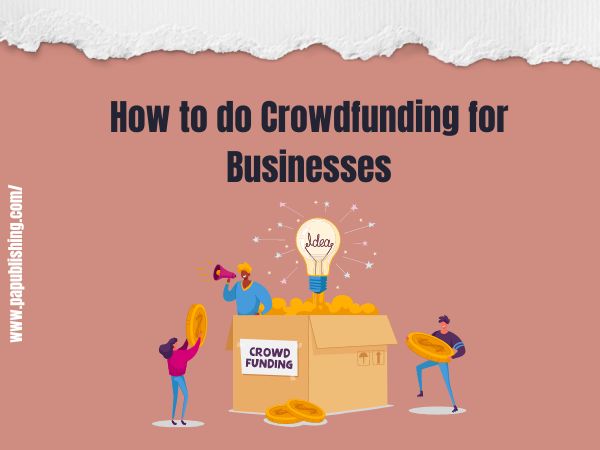How To Do Crowdfunding For Business?
Crowdfunding for business has revolutionized the way entrepreneurs raise capital. By leveraging the power of the internet and social networks, businesses can gather small amounts of money from a large number of people. According to recent statistics, the global crowdfunding market is expected to increase by 1.48 percent from 2024 to 2028.
This write-up will walk you through essential steps to successfully crowdfund for your business. The following steps will help you assess the right platform and engage effectively with potential backers.
Everything About Crowdfunding for Business!
Crowdfunding involves raising small amounts of money from a large group of people, typically via the Internet. It’s a modern alternative to traditional financing methods like bank loans or venture capital. The process includes setting a finding goal, creating a campaign on a crowdfunding platform, and promoting it to attract backers.
Types of Crowdfunding
Each type of crowdfunding offers unique benefits and suits different business needs. Understanding these types will help you choose the best method for your campaign.
- Reward-Based Crowdfunding
Reward-based crowdfunding is the most common type of financial contribution. Backers contribute funds in exchange for a tangible item or service. This model is popular on platforms like Kickstarter and Indiegogo.
For instance, a startup might offer early access to a new product or exclusive merchandise. This method is particularly effective for creative projects, tech gadgets, and consumer products.
- Equity Crowdfunding
Equity crowdfunding for businesses involves selling shares to investors. In return for their contributions, investors receive equity ownership. This model is regulated and typically hosted on platforms like StartEngine and SeedInvest.
This type is best for startups that need substantial capital and are willing to share ownership. The best part about equity crowdfunding is that it can attract both accredited and non-accredited investors.
- Donation-Based Crowdfunding
This crowdfunding is primarily used by nonprofits and charitable organizations. Contributors do not expect any return for their donations. Platforms like GoFundMe are popular for this type. Businesses with a social cause or community project can also use this model.
This type is best suited for initiatives that aim to generate social impact rather than financial returns. Remember, to establish such crowdfunding your brand must have a strong and engaging business plan and motive.
- Debt Crowdfunding
This type of crowdfunding for business is also known as peer-to-peer lending. It involves borrowing money from backers with the promise to repay with interest. The platforms best suited for this are LendingClub and Funding Circle.
The businesses that prefer not to give up equity but need to raise funds can go for this debt crowdfunding. Potentially lower interest rates make it advantageous compared to traditional loans. To ensure success in this type of crowdfunding businesses must have a solid repayment plan.
Choosing the Right Platform
Selecting the appropriate platform for crowdfunding is crucial for the success of your campaign. Each platform has its unique features, fees, and audience, which impact your fundraising efforts. Here are some factors to consider when choosing a platform:
- Fees and Costs
Crowdfunding for business platforms charges fees that can impact the total funds raised. Kickstarter and Indiegogo charge around 5% of the setup fee. However, there is a slight change in its processing fee. Kickstarter charges 3%+0.2c, whereas Indiegogo has a specified 3%+0.3c payment processing fee. It is essential to compare these costs to ensure they fit within your budget.
- Success Rates
Success rates are a crucial factor in determining the credibility of crowdfunding platforms. Kickstarter has an 82% success rate. In contrast, the GoFundMe campaigns tend to have lower success rates but are effective for charitable causes and personal fundraising.
- Funding Model
Decide between all-or-nothing or keep-what-you-raise models. Kickstarter uses an all-or-nothing approach, meaning you only receive funds if you reach your goal. Indiegogo offers flexible funding options that help you keep whatever you raise even if you don’t meet your goal.
- Audience and Reach
Different platforms cater to different audiences. Indiegogo attracts a global audience that is attracted to technical and business projects. On the contrary, GoFundMe appeals to those looking to support personal or social causes.
How To Prepare Your Campaign?
Successful crowdfunding for business requires special preparation. Start by setting a clear and realistic funding goal based on your business needs and research. A detailed plan helps backers understand your objectives and increases trust.
- Create a Compelling Story:
Your campaign should tell a captivating story. Explain why your business needs funding and how it will benefit from the support. Personal stories or impactful narratives can resonate well with potential backers.
- Develop Attractive Rewards:
For reward-based crowdfunding for business, ensure your rewards are desirable and relevant to your product or service. Offering early access, exclusive items, or personalized experiences can entice more backers.
- Produce High-quality Visuals:
High-quality images and videos are crucial. Research states that campaigns with videos raise 105% more than those without. Professional visuals can help showcase your product and engage potential backers.
- Plan Your Marketing Strategy:
Use social media, email marketing, and other channels to promote your business before and during its launch. Consistent updates and transparent communication with your audience can significantly boost your campaign’s success.
Launching the Campaign
Launching your crowdfunding for business campaign is a critical phase that requires strategic execution. Here are key steps to effectively launch your campaign:
Promote Widely:
Before launching, build anticipation by teasing your campaign on social media, in your newsletter, and through your personal network. Use platforms like Facebook, Twitter, and LinkedIn to reach a broader audience and generate buzz.
Engage with Backers:
Active engagement is crucial. Respond to questions and comments promptly to build trust and maintain momentum. So, it is best to share milestones, challenges, and successes to keep backers informed and invested in your journey.
Monitor Progress:
Track your campaign’s performance closely. Use analytics provided by your crowdfunding platform to understand what’s working and what needs adjustment. If certain marketing efforts are driving more traffic or contributions, focus more resources there.
Use Early Momentum:
Aim to raise at least 30% of your funding goal within the first week. Campaigns that achieve this milestone are significantly more likely to reach their full funding target. Encourage friends, family, and loyal customers to contribute early and share the campaign to help build initial momentum.
Post Campaign Follow-Up
The post-campaign follow-up is crucial for maintaining trust and fostering long-term relationships with your backers. Start by providing regular updates on the progress of your project. Transparency is key; backers appreciate knowing how their contributions are being utilized and any challenges you face.
Express Gratitude
Show appreciation to your backers through personalized thank-you messages, exclusive updates, or additional perks. A simple gesture of gratitude can go a long way in building a loyal community around your brand.
Engage Continuously
Keep your backers engaged even after the campaign ends. Invite them to follow your journey through social media, newsletters, or community forums. Continuous engagement can turn one-time backers into long-term supporters and advocates for your business.
Common Questions About Crowdfunding
Can I Crowdfund For Business?
Crowdfunding is a popular method for businesses to raise funds for new projects, product launches, or expansion efforts. It allows businesses to tap into a broad network of potential backers, including customers, fans, and investors.
Is Crowdfunding Allowed For LLCs?
Yes, crowdfunding is allowed for LLCs. However, the specific regulations and requirements can vary depending on the type of crowdfunding and the platform used. For equity crowdfunding, LLCs must comply with SEC regulations, which may involve providing financial disclosures and adhering to investment limits.
Do You Pay Back Crowdfunding?
It depends on the type of crowdfunding used. Reward-based and donation-based crowdfunding do not require repayment, as backers contribute funds in exchange for rewards or out of goodwill. However, debt crowdfunding involves borrowing money that must be repaid with interest.
Is Crowdfunding For Business Taxable?
Generally, funds raised through crowdfunding are considered taxable income by the IRS. The tax implications can vary depending on the type of crowdfunding and the structure of the campaign. For example, reward-based crowdfunding contributions are typically seen as taxable income, whereas donations may not be taxable if they are used for charitable purposes.
Conclusion:
Crowdfunding for businesses offers a viable alternative to traditional funding methods. By understanding the basics of crowdfunding, you can successfully raise the capital needed to grow your business! Need more information on your business ventures? Visit PApublishing!


